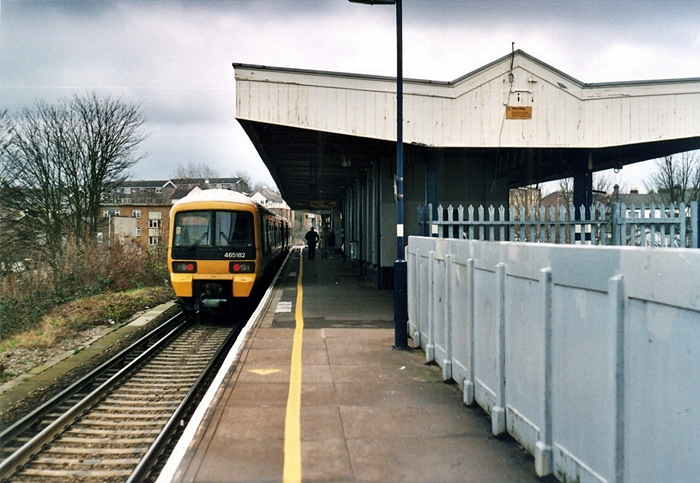
Nunhead
In addition to a new station, a three-storey-high substation was erected within
the fork of Nunhead Junction. This comprised a steel frame, surrounded by red
brick, and housed three 1500kW rotary converters. The original goods yard here
remained in situ, along the northern side of the running lines, beside the
former site of the first station. However, it was now overlooked by a new
38-lever signal box, built on the ‘’up’’ side of the running lines, again
beside the old site of the LC&DR station. The cabin was built to an in-house SR
design, although showed traces of those much earlier signal boxes built by Saxby &
Farmer in the late 19th Century.
Electrification of the Charing Cross lines in February 1926 caused problems for
goods traffic, which remained substantial from north of the Thames. Until this
time, the Hither Green freights which came through Blackfriars were routed onto
ex-SER lines via London Bridge and New Cross. The accelerated timetable made it
difficult to slot slow freights in-between fast passenger services. The solution
lied with the defunct Greenwich Park branch. At this time, the line remained
virtually complete; the section between Nunhead and Brockley Lane was still
serviceable, since freights continued to use the LNER goods depot at the latter.
Beyond, the line was complete, but in a severe state of decay. The decision was
taken to restore the double-track between Nunhead and the closed Lewisham Road
station. Thereafter, a completely new spur would connect the line with ex-SER
rails at Lewisham Junction. The spur was to be carried over the Lewisham
avoiding lines upon a huge lattice girder span of steel construction. The
refurbished line came into use on 30th June 1929, and it was dedicated to freight
traffic from the outset, thus lacked third rail. It was signalled throughout
with four-aspect colour lights, but semaphores were retained at Nunhead
Junction.
During 1935, third rail was laid along the Nunhead to Lewisham connection and
public electric services commenced over the line on 30th September of that year.
A boom in passenger traffic as a result of electrification required additional
trains to run on all three North Kent routes from Dartford. Of those peak-hour
St Paul’s services which ran on Bexleyheath and Sidcup lines, it was decided to
divert a number onto the spur at Lewisham and through to Nunhead, freeing up
capacity on the London Bridge approaches.
The Crystal Palace branch suffered a second period of wartime closure between
22nd May 1944 and 4th March 1946. On absorption into British Railways in 1948,
the days of the line were clearly numbered. Even before the destruction of
Crystal Palace by fire in November 1936, passenger numbers had been
consistently low, and the general locality was thought to be better served by
the Central Division line through the Low Level station. The last timetabled
services ran along the Crystal Palace branch on
Saturday 18th September 1954, and this became one of very few electrified lines
to close. Little under five years later, signalling alterations took place at Nunhead in connection with the Kent Coast Electrification. Colour light signals
replaced semaphore signals between Factory Junction and Nunhead on 8th March
1959, and between the latter and Ravensbourne on Sunday 22nd of the same month.
Signal boxes at Crofton Park and Catford were abolished, but that at Nunhead
retained to control the new signals. For this purpose, a relay room came into
use beside the signal box’s western elevation.
Nunhead goods yard dated back to the original LC&DR station and its closure
finally came on 2nd April 1962. Beyond this date, freight traffic was still
handled at Brockley Lane on the Lewisham connecting line, but this too ceased on
4th May 1970. Advancements in signalling over a decade later saw Nunhead signal
box decommissioned: its functions were taken over by the Victoria Panel
(located at Clapham Junction) on 17th January 1982. Partial station
reconstruction in 1989 saw the island rebuilt in prefabricated concrete and the
incorporation of a ticket booth upon it. This allowed the booking hall at street
level to be taken out of use. The red brick building was subsequently demolished
and the station entrance opened up.
23rd February 2007

Shortly after the Class 37s' cameo appearance, Class 60 No. 60095 appeared with the Acton to Cliffe empty
Brett hoppers. Since the line through Snow Hill Tunnel ceased to be used by cross-London freights on 23rd
March 1969, such trains from north of the Thames have been required to travel via the West London Line
and Clapham Junction. David Glasspool
23rd February 2007

''Networker'' No. 465182 had arrived from London Victoria with a Dartford service. This unit has since been
fitted with new traction drive by Hitachi, which aims to improve unit reliability. The work took place on all
Class 465/0 and 465/1 units at the company's Ashford depot between April 2009 and April 2010. David Glasspool
Return to the Kent Rail Homepage or alternatively, check for Updates.
Website & Copyright information - Links - Contact the Webmaster
All content is copyright © David Glasspool unless otherwise stated